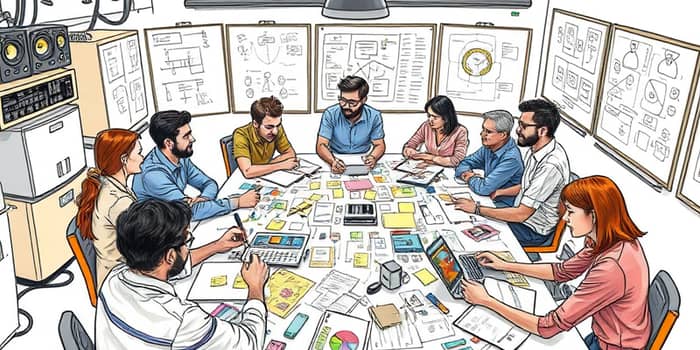
In any ambitious endeavor, the path from concept to completion is rarely linear. Whether you are leading a team, developing a new product, or designing a course of study, allowing for trial and error in your early planning stages is critical. By embedding experimentation into your strategy, you unlock a dynamic cycle of learning that can guide you toward more robust and innovative solutions.
Systematic learning through experimentation transforms every setback into a stepping stone. Rather than fearing mistakes, you can treat them as vital clues that illuminate the road ahead. When failures become data points instead of dead ends, you gain clarity and confidence in your vision.
Research in behavioral economics highlights that agents who embrace experimentation diverge positively from their peers over time, closing knowledge gaps and building durable advantages. This pattern confirms that early-stage trials can pay dividends far beyond the initial effort.
At this stage, cultivating a mindset that welcomes ambiguity is as important as the experiments themselves. Establish rituals—such as brainstorming sessions dedicated to wild ideas—that encourage creative thinking without immediate judgment.
Trial and error is the engine behind many breakthroughs. Leaders who champion a test-driven approach often uncover novel strategies and products that would otherwise remain hidden. Risk and uncertainty are not obstacles but essential elements of creativity and growth.
Innovation rarely springs from certainty. By dedicating resources to pilot phases, you create protected spaces for creativity, where unconventional ideas can be tested and refined without jeopardizing core operations.
As one expert notes, “Innovation is often the key to sustained progress, yet innovation itself is difficult and highly risky.” Embracing experimentation helps navigate this complex terrain by turning uncertainty into actionable data. When experiments willingly challenge assumptions, they spark creativity and drive progress beyond incremental improvements.
Errors should be viewed as valuable information for future action. Each unsuccessful trial narrows the field of possibilities and increases the odds of success. This mindset shift requires defining rapid, short-term metrics that reveal insights quickly, allowing you to pivot or persevere based on clear evidence.
Without swift feedback, mistakes can become demoralizing rather than instructive. By setting proximal outcomes—small, observable goals—you can track progress continuously and celebrate incremental wins that keep momentum alive.
Effective learning from failure also depends on honest reflection. Post-mortems should focus on processes and decisions, not personal blame, ensuring every team member contributes lessons and ideas for improvement.
When organizations shun experimentation, they risk stagnation. An overemphasis on maintaining the status quo leads to missed chances for innovation and long-term decline. Leaders who cling to rigid, long-range plans often find themselves outpaced by more agile competitors who harness the lessons of trial and error.
Leaders must recognize that short-term comfort often leads to long-term pain. Avoidance of small failures can result in catastrophic errors later, when stakes are higher and course correction is more expensive. Cultivating an appetite for manageable risks early can safeguard against this vulnerability.
Performance-trap phenomena show that those with past failures often avoid new experiments, deepening gaps with more proactive peers. Breaking this cycle requires deliberate encouragement and resources for low-stakes trials.
Multiple studies confirm that organizations that prioritize experimentation outperform their peers. A five-year analysis revealed that companies with a test-driven approach achieved 30% faster revenue growth compared to those that adhered strictly to pre-defined plans. This difference can be traced back to their ability to adapt swiftly to market feedback and evolving customer needs.
Behavioral scientists also show that experiment-averse teams consistently underperform as their members develop a fixed mindset, perceiving every failure as a personal shortcoming instead of a learning opportunity. Encouraging a growth mindset can reverse this trend and promote resilience.
To make trial and error an integral part of your planning, follow a clear framework that channels uncertainty into productive action:
Integrating this cycle into project management routines empowers teams to adapt to shifting landscapes. Short sprints, whether weekly or biweekly, provide consistent checkpoints that keep experiments manageable and the learning process transparent.
A resilient organization values curiosity and open dialogue. Psychological safety must be a priority so that team members feel comfortable sharing mistakes and insights without fear of reprisal. This trust forms the bedrock of collaborative learning.
Building rituals around learning—such as regular show-and-tell sessions—makes trial and error a visible, shared journey rather than a hidden side project.
Across industries, the trial-and-error approach has proven its worth:
Consider a startup that launched a minimum viable product (MVP) to gather real user feedback. Through a series of A/B tests, the team identified which features resonated best, then iterated rapidly. This approach reduced development costs by 40% and improved user retention by 25% within six months.
Each example highlights the importance of iterative assessment and adjustment. Small, evidence-based changes accumulate to produce significant advancements over time.
Even with the best intentions, trial and error can falter if mismanaged. Avoid these common mistakes:
Maintaining discipline in data collection and decision-making helps ensure that experiments provide clear guidance rather than confusion.
Allowing for trial and error in your early planning stages is not a concession to chaos; it is a strategic choice that fosters innovation, resilience, and continuous growth. By treating failures as lessons, embedding iterative loops into your process, and building a culture that values learning, you position yourself for enduring success.
Embrace uncertainty as an ally in your journey, and watch as your ideas evolve into transformative realities. Your willingness to test, learn, and adapt will become your greatest competitive advantage.
Begin today by identifying a small assumption you can test. Take one step into the unknown and gather data. Then, iterate. Over time, these small experiments will weave together to form a tapestry of innovation that propels you forward.
References













